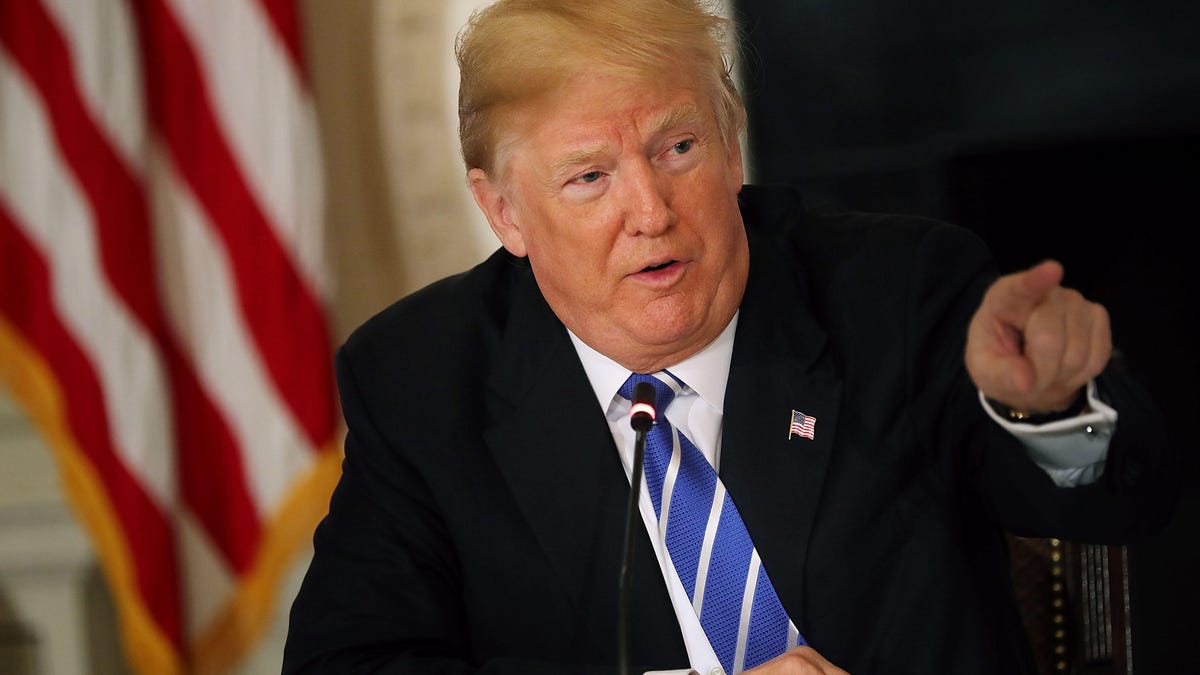Trump infrastructure plan leaves out rural broadband funding
Lawmakers and broadband providers from rural areas were hoping for dollars aimed specifically at solving the digital divide. They instead got money states can use how ever they want on infrastructure.

President Donald Trump speaks Monday during a meeting with state and local officials to unveil his administration's long-awaited infrastructure plan.
President Donald Trump's $200 billion infrastructure proposal released Monday includes $50 billion in funding for rural communities, but nothing specific for broadband deployment.
Even though Trump has talked about the importance of expanding broadband in rural areas, he has not committed any funding to help build networks. Instead, his efforts have been aimed at eliminating red tape and regulation to get infrastructure built.
The proposal, which makes no mention of broadband infrastructure, is meant to spur the investment of at least $1.5 trillion in infrastructure, according to a White House fact sheet. Under the plan, the feds would contribute a total of $200 billion over the next 10 years. About half that money would be used as part of an incentive program to entice private investors as well as city, state and local governments to invest in infrastructure projects.
Rural communities are expected to get $50 billion of the $200 billion in direct federal funding to "rebuild and modernize infrastructure" in rural America, according to the fact sheet. How the funds will be spent will be largely up to individual states. In theory, this could mean that some states could use the money on broadband expansion projects. But the emphasis from the White House seems to be on traditional types of infrastructure, according to the fact sheet, which starts off with a quote from the president's State of the Union speech last month.
"We will build gleaming new roads, bridges, highways, railways, and waterways all across our land," he said. "And we will do it with American heart, and American hands, and American grit."
The proposal comes as the Federal Communications Commission estimates 39 percent of people living in rural regions do not have access to broadband, compared with just 4 percent of people in cities. The reason is simple. In sparsely populated areas, it's not economical for private industry to deploy infrastructure.
But so far neither Trump's executive order for rural broadband expansion signed last month nor his infrastructure spending proposal offer new funding to promote broadband deployment in rural areas. Instead, the administration is focused on establishing policies to "get government out of the way" as companies look to deploy fiber links and high-speed wireless technologies to serve these areas.
Ajit Pai, the Trump-appointed chairman of the FCC, has backed the president's approach to solving the digital divide for rural Americans.
"Too often, regulatory barriers make it harder and more expensive to build out broadband than it needs to be -- to the detriment of American consumers," he said in a statement. "That's why this plan is a welcome and strong call to action."
But Democrats in rural areas are troubled that Trump's plan doesn't commit any dollars to solving the digital divide for rural communities.
"I am deeply disappointed that the president failed to include dedicated broadband funding in his infrastructure proposal," Rep. Peter Welch a Democrat from Vermont said in a statement. "This glaring omission is a betrayal of the rural voters that supported him in his election, and a missed opportunity to close the digital divide that separates rural and urban America."
In January 2017, Welch led 71 members of the House in a bipartisan letter to Trump urging him to include investments in rural broadband in his infrastructure proposal. Last month, he and the six co-chairs of the bipartisan House Rural Broadband Caucus sent another letter.
"Rural communities must have adequate broadband infrastructure to attract and retain businesses and human resources, close the homework gap for students and teachers, open innovative and convenient pathways to telemedicine for seniors and providers, and help farmers increase efficiencies in their barns and on their land," the lawmakers said in their January 2018 letter. "The future wellbeing of our communities is dependent upon this technology."
It's not just politicians upset by the lack of dedicated funding for rural broadband. USTelecom, a trade group representing smaller broadband providers many of which serve rural areas, blasted the White House for what it considers an oversight.
"Closing the digital divide, particularly in our nation's most difficult to reach rural areas, requires dedicated and adequate capital -- both financial and political," Jonathan Spalter CEO of USTelecom said in a statement. He noted that the industry has already invested $1.6 trillion over the past two decades to building broadband infrastructure. But he added that "significant, direct support from the federal government is critical to bringing broadband's benefits to all."
Still, other industry groups like NCTA, which represents large cable companies, and CTIA, which lobbies on behalf of the wireless industry, applauded the president's proposal, especially its efforts to reduce regulation and cut through red tape to make deployment of infrastructure easier.
"U.S. wireless companies are poised to invest $275 billion to provide 5G," Meredith Attwell Baker, president and CEO of CTIA, said in a statement. "And we look forward to working with the administration and Congress to implement policies that will speed the permitting and deployment of new mobile broadband infrastructure."
Security: Stay up-to-date on the latest in breaches, hacks, fixes and all those cybersecurity issues that keep you up at night.
CNET en Español: Get all your tech news and reviews in Spanish.

